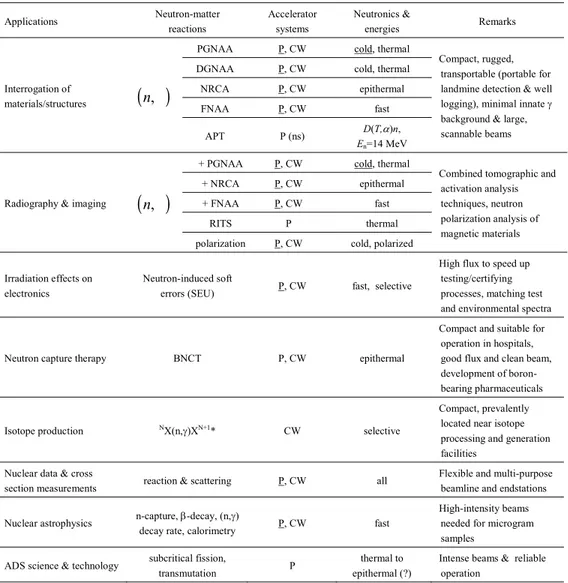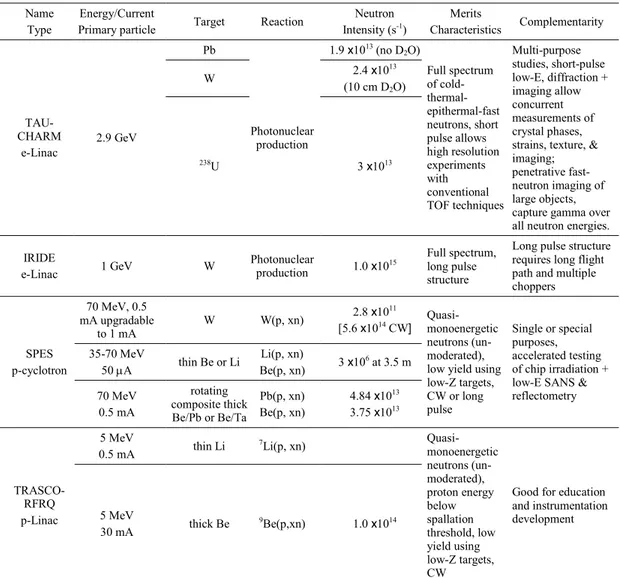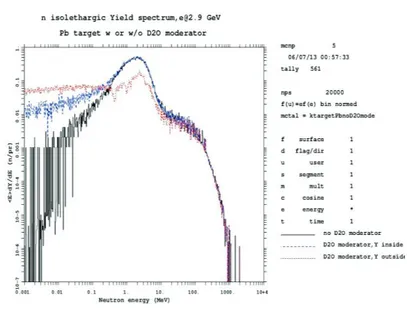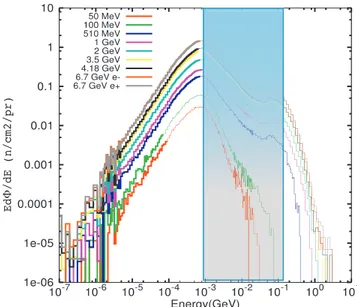Physics Procedia 60 ( 2014 ) 228 – 237
1875-3892 © 2014 The Authors. Published by Elsevier B.V. This is an open access article under the CC BY-NC-ND license (http://creativecommons.org/licenses/by-nc-nd/3.0/).
Peer-review under responsibility of the Organizing Committee of UCANS III and UCANS IV doi: 10.1016/j.phpro.2014.11.032
ScienceDirect
Union of Compact Accelerator-Driven Neutron Sources (UCANS) III & IV
Applications of compact accelerator-driven neutron sources:
an updated assessment from the perspective of materials
research in Italy
C. Andreani
a, I. S. Anderson
b, J. M. Carpenter
c, G. Festa
a, G. Gorini
d,
C.-K. Loong
e, and R. Senesi
aaUniversità degli studi di Roma Tor Vergata Centre NAST and Physics Department, Rome, Italy bOak Ridge National Laboratory, Oak Ridge, TN USA
cArgonne National Laboratory, Argonne, IL USA dUniversita' degli Studi di Milano - Bicocca, Milano, Italy eUniversità degli studi di Roma Tor Vergata Centre NAST, Rome, Italy
Abstract
In 2005 the International Atomic Energy Agency (IAEA) in Vienna published a report [1] on ‘Development Opportunities of Small and Medium Scale Accelerator Driven Neutron Sources’ which summarized the prospect of smaller sources in supporting the large spallation neutron sources for materials characterization and instrumentation, a theme advocated by Bauer, Clausen, Mank, and Mulhauser in previous publications [2-4]. In 2010 the Union for Compact Accelerator-driven Neutron Sources (UCANS) was established [5], galvanizing cross-disciplinary collaborations on new source and neutronics development and expanded applications based on both slow-neutron scattering and other neutron-matter interactions of neutron energies ranging from 10-6 to 102 MeV [6]. Here, we first cover the recent development of ongoing and prospective projects of compact accelerator-driven neutron sources (CANS) but concentrate on prospective accelerators currently proposed in Italy. Two active R&D topics, irradiation effects on electronics and cultural heritage studies, are chosen to illustrate the impact of state-of-the-art CANS on these programs with respect to the characteristics and complementarity of the accelerator and neutronics systems as well as instrumentation development.
© 2014 Published by Elsevier Ltd. Selection and/or peer-review under responsibility of UCANS Keywords: Compact accelerator-driven neutron sources; chip irradiation; neutron radiography; Italian accelerator projects.
*Corresponding author.
E-mail address: [email protected].
© 2014 The Authors. Published by Elsevier B.V. This is an open access article under the CC BY-NC-ND license (http://creativecommons.org/licenses/by-nc-nd/3.0/).
1. Introduction
The 21st century has witnessed a rapid advancement of big, MW-power-level, accelerator-based neutron sources, notably the operation of the SNS in the US and J-PARC in Japan, and the ongoing ESS project of the EU. While the adept, ~100 kW-level spallation sources, e.g., ISIS in UK and the lead research reactors, e.g., ILL in France will continue to play an important role in serving the neutron-scattering user communities beyond 2020, the prospect of older and smaller neutron facilities (~10 kW accelerator-driven sources and ~5 MW fission reactors) are subjected to scrutiny. With regard to small accelerator-driven sources, their role in supporting the big sources for materials characterization, neutron instrumentation and technical development, and education was recognized before the commissioning of the big sources by the IAEA and neutron-scattering communities [1-4]. It is not until a few year ago the usefulness of the compact accelerator-driven neutron sources (CANS) for new, cross-disciplinary applications—not only for slow-neutron scattering but also for education, fundamental and applied research, and development of instruments and commercial products by making use of a wide spectrum of neutron-matter interactions and taking advantage of the small size, high flexibility, and low cost—was realized [5]. For this reason, new accelerator systems, neutronics and beam-shaping assemblies, and instrumentation are needed within a much expanded scope. The UCANS was established to promote such international and interdisciplinary collaborations [5, 6].
Nomenclature
CANS Compact Accelerator-driven Neutron Sources loosely encompass low-energy proton-, deuteron-, and electron-accelerators, in linear or circular configurations, of moderate beam power (< ~30 kW) even though the size of an electron linac may not be ‘compact’ in the traditional sense. Additionally, we also include fusion-based compact neutron generators, and emerging technologies of table-top laser-driven neutron sources, and micro-size ‘neutristors’ [7] into the CANS family.
UCANS Union for Compact Accelerator-driven Neutron Sources. http://toybox.qe.eng.hokudai.ac.jp/ucans4/
PGNAA Prompt gamma neutron activation analysis DGNAA Delayed gamma neutron activation analysis NRCA Neutron resonance capture analysis FNAA Fast neutron activation analysis APT Associated particles technique
RITS Rietveld imaging transmission spectroscopy BNCT Boron neutron capture therapy
SEU Single event upset. A ‘single event effect’ (SEE) is a phenomenon whereby the correct operation of a microelectronic device is disrupted by interaction with a single sub-atomic particle. SEEs in devices, which range from ‘soft’ errors that involve single or multiple bit upsets that corrupt memory or change logic function to ‘hard’ catastrophic errors that lead to a permanent destructive failure of the electronics. Neutron-induced SEUs have become a dominant reliability issue for the avionics and electronics industries.
Table 1. Preferred characteristics of CANS applications. The underlined items represent the preferred configurations. Applications Neutron-matter reactions Accelerator systems Neutronics & energies Remarks Interrogation of materials/structures
(
n,)
PGNAA P, CW cold, thermal
Compact, rugged, transportable (portable for landmine detection & well logging), minimal innate J background & large, scannable beams
DGNAA P, CW cold, thermal
NRCA P, CW epithermal
FNAA P, CW fast
APT P (ns) D(T,D)n,
En=14 MeV
Radiography & imaging
(
n,)
+ PGNAA P, CW cold, thermal
Combined tomographic and activation analysis techniques, neutron polarization analysis of magnetic materials + NRCA P, CW epithermal + FNAA P, CW fast RITS P thermal
polarization P, CW cold, polarized Irradiation effects on
electronics
Neutron-induced soft
errors (SEU) P, CW fast, selective
High flux to speed up testing/certifying processes, matching test and environmental spectra
Neutron capture therapy BNCT P, CW epithermal
Compact and suitable for operation in hospitals, good flux and clean beam, development of boron-bearing pharmaceuticals
Isotope production NX(n,J)XN+1* CW selective
Compact, prevalently located near isotope processing and generation facilities
Nuclear data & cross
section measurements reaction & scattering P, CW all
Flexible and multi-purpose beamline and endstations Nuclear astrophysics n-capture, E-decay, (n,J)
decay rate, calorimetry P, CW fast
High-intensity beams needed for microgram samples
ADS science & technology subcritical fission,
transmutation P
thermal to epithermal (?)
Intense beams & reliable operation
While preserving the role in education and training that complements large neutron-scattering user facilities, the UCANS community has found novel applications through combined examination of the scattered and transmitted neutrons, the emitted quanta induced by neutrons and the irradiation effects on soft and hard matters over a broad spectrum of cold, thermal, epithermal and fast neutrons. In principle, CANS can lend themselves to applications of the following fields: interrogation of materials/structures, radiography and imaging, irradiation effects on electronics, neutron capture therapy, isotope production, nuclear data and cross-section measurements, nuclear astrophysics, and ADS science and technology.
Table 1 broadly lists the desirable characteristics of the underlying neutron-matter interactions, accelerator systems (Pulsed, P, or Continuous, CW), neutronic performance, and instrumentation capabilities for each category of applications.
Table 2. The characteristics and complementarity of prospective accelerator projects in Italy. Name
Type
Energy/Current
Primary particle Target Reaction
Neutron Intensity (s-1) Merits Characteristics Complementarity TAU-CHARM e-Linac 2.9 GeV Pb Photonuclear production 1.9 x1013 (no D 2O) Full spectrum of cold- thermal-epithermal-fast neutrons, short pulse allows high resolution experiments with conventional TOF techniques Multi-purpose studies, short-pulse low-E, diffraction + imaging allow concurrent measurements of crystal phases, strains, texture, & imaging; penetrative fast-neutron imaging of large objects, capture gamma over all neutron energies.
W 2.4 x10 13 (10 cm D2O) 238U 3 x1013 IRIDE e-Linac 1 GeV W Photonuclear production 1.0 x1015 Full spectrum, long pulse structure
Long pulse structure requires long flight path and multiple choppers SPES p-cyclotron 70 MeV, 0.5 mA upgradable to 1 mA W W(p, xn) 2.8 x10 11 [5.6 x1014 CW] Quasi-monoenergetic neutrons (un-moderated), low yield using low-Z targets, CW or long pulse Single or special purposes, accelerated testing of chip irradiation + low-E SANS & reflectometry 35-70 MeV 50 PA thin Be or Li Li(p, xn) Be(p, xn) 3 x10 6 at 3.5 m 70 MeV 0.5 mA rotating composite thick Be/Pb or Be/Ta Pb(p, xn) Be(p, xn) 4.84 x1013 3.75 x1013 TRASCO-RFRQ p-Linac 5 MeV 0.5 mA thin Li 7Li(p, xn) Quasi-monoenergetic neutrons (un-moderated), proton energy below spallation threshold, low yield using low-Z targets, CW
Good for education and instrumentation development 5 MeV
30 mA thick Be
9Be(p,xn) 1.0 x1014
The pulsed-mode operation of CANS in general is preferred because the time structure of the neutron flux may permit time-of-flight measurements of the neutron energy distribution. Certain limitations may exist depending on specific applications. Clearly, a detailed elaboration of the above categories of applications is beyond the scope of this paper. Here, we focus on a discussion of the prospective CANS projects in Italy and their impact on the R&D subfields of cultural heritage study under the categories of interrogation of materials and radiography/imaging, and neutron-induced SEEs on electronics.
2. Prospective CANS projects in Italy
The Italian neutron community, under the consolidated support of the Consiglio Nazionale delle Ricerche (CNR) for participations in major European neutron facilities such as the Institut Laue Langevin (ILL) and ISIS facility over the years, has grown to several hundreds of scientists, including users and
expert teams in instrument development, with the majority of the users coming from CNR and academia, with education in biology, chemistry, engineering, physics, and other fields is a strong component of the neutron-related R&D activities.
The new accelerator physics plans currently under study in Italy, such as the IRIDE, SPES and TAU/CHARM projects can potentially host CANS and hence support a wide range of applications. Some of the parameters of these projects are summarized in Table 2. A CANS to be designed and built afresh can in principle tailor its parameters within the realm of the driving accelerator to achieve utmost efficacy for materials research, serving a number of independent scattering instruments. One aspect to bear in mind is that, generally speaking, a short pulse (~1 Ps) source readily provides a wider range of opportunities/applications than a long pulse or pseudo-continuous source. This comes about because the pulse structure naturally lends itself to the study of both dynamic and kinetic properties of materials.
Among potential applications that are well suited to the strengths of the Italian research and industrial communities are two subfields of neutron-induced SEU in computer chips and non-intrusive/non-destructive studies of artifacts and relics for cultural heritage.
2.1. Chip irradiation
The interaction of cosmic rays with the earth’s atmosphere generates showers of particles including high energy neutrons. Spallation neutrons are produced in this way (principally by protons) colliding with atmospheric nuclei (e.g., N and O) in the Earth’s stratosphere (20-50 km above sea level). Due to charge neutrality and consequent long range, neutrons shower all aeronautical and terrestrial substances along the way, thus representing a particular threat to aircraft avionics, with problems ranging from wiping a device’s memory, to interrupting its normal behaviour, to permanently damaging the electronics. At normal aircraft flying altitudes of 30,000 to 35,000 feet, these neutron showers are intense enough to potentially disrupt the correct operation of aircraft electronics through Single Event Effects (SEE) (Fig. 1). Owing to their very high energies (~102 MeV) and substantial fluxes (~20 n/cm2/h integrated over all
energies > 1 MeV at sea level, decreasing according to the atmospheric pressure and increasing with magnetic latitude), neutron-induced SEE in electronic chips is a critical concern to modern society.
Investigations of SEE in computer chips commonly employ large high-power neutron sources for irradiation such as the LANL facility in the US. An international research program on neutron-induced SEEs, between Italy and the UK, supported under the current CNR-STFC (Science Technology Facility Council) agreement for ISIS, has been initiated in 2007, first by exploratory experiments using the VESUVIO spectrometer at ISIS and subsequently by building a dedicated instrument CHIPIR also at the Second Target Station, TS2, at ISIS. CHIPIR is expected to be commissioned in 2014. It will provide a world-leading integrated fast neutron flux >1×106 n/cm2/s (10 < E < 800 MeV integrated) with selectable
attenuation hence a favourable accelerated testing rate to the industry. However, the cross section should ideally be measured as a function of incident energy, particularly over the 1-200 MeV interval so that the threshold-like behaviour that differs among electronic RAMs can be determined (see Fig. 1). The ISIS and LANL sources are not neutron-energy selective due to the nature of the spallation process and ‘quasi-monoenergetic’ neutron sources (QMNS) such as the TSL (Uppsala) lack tuneability and its spectrum contains, in addition to the narrow, quasi-monoenergetic peak, a broad component extending to low energies comprising up to ~40% of the incident flux. Therefore at present, spectrum-integrated neutron-induced error rates are the best achievable measured quantities.
Fig. 1. The soft error cross sections,
( )
E , versus energy for SEE in chip irradiation. The curves show the energy dependence of the cross section of SEE for different SRAM and DRAM electronics. They exhibit a threshold-like behavior which depends on the electronics type. The measured neutron soft error rate isR =
( )
E( )
E EminEmax
dE (1)
where
( )
E
is the differential neutron flux. If the incident flux has a broad energy distribution, the sharp rise in energy near the threshold of( )
E is difficult to extract from the measured energy-integrated quantity.A monoenergetic and energy-tuneable CANS covering the range of 1-200 MeV would bridge the gap of direct measurements of threshold-like behaviour in the soft error cross section, a capability currently lacking in large spallation sources and QMNS, and expand the field to the next level of sophistication. Therefore, we conducted a preliminary examination of the prospect of accommodating such CANS within the accelerator plans currently under investigation in Italy. A ‘SPES like’ source (see Table 2) promises to be a unique source for chip irradiation in that, by changing proton energy in conjunction with employing multi-component targets, it may deliver a tuneable neutron beam up to 70 MeV which meets the chip-irradiation requirements of a monoenergetic spectrum at ~95% level. A major challenge is to improve the source intensity to a level that is deemed valuable and viable to the electronics industry.
Photonuclear reaction-based sources, such as the IRIDE (a 1.0 GeV e-linac source) and TAU-CHARM (a 2.9 GeV e-linac source) characteristically produce a broad spectrum of neutrons. Fig. 2 shows the Monte Carlo simulation of the isolethargic spectrum of photonuclear production from TAU-CHARM at
high energies using a Pb target—a cylinder of 3.5×8 cm2—with (blue and red lines) and without (black
line) a spherical crown of a 10-cm D2Omoderator. The calculated yields at the emitting surface and in the
interior of the moderator are denoted by the read and blue lines, respectively. Three cases of neutron
yields per primary particle for TAU-CHARM using a Pb, W, or 238U target are given in Table 2.
Fig. 3 shows neutron flux spectra of neutrons emerging from a W target for IRIDE and TAU-CHARM. The shaded region represents the relevant neutron energy range for chip irradiation cross-section measurements of Fig. 1. Due to the nature of photonuclear reactions, neither source can deliver a quasi-monochromatic neutron beam and the time-of-flight method is not applicable at these neutron energies. However, they can both be used for irradiation measurements using an integrated fast neutron flux with selectable attenuation.
2.2. Neutron imaging
The strength of neutron imaging and radiography is founded upon the unique properties of the neutron: large penetration depth (~cm) into bulk materials, keen sensitivity to light atoms such as hydrogen, high
Fig. 3. The calculated neutron flux spectra of IRIDE and TAU-CHARM – from the IRIDE white book (http://www.lnf.infn.it/accelerator/public/iride/IRIDE_White_Book)] (see text).
contrast between adjacent elements in the periodic table, and remarkable magnetic interaction between the neutron spin and electronic magnetization. Examples of recent success are neutron imaging of the real-time motion of water in fuel cell channels and the flow of lubricants in combustion engines, as well as tomographic rendering of magnetization distribution in magnets and superconductors. Thus far most outstanding neutron imaging techniques have been developed at reactor sources. However, on account of the inherent pulsed-mode operation, the compactness, transportability, and flexibility of CANS, user-friendly and economically competitive neutron imaging machinery on a par with x-ray or MRI devices can be developed for a variety of uses in factories, hospitals, or on location. An outstanding forte of CANS is to effectively utilize epithermal (~0.1-2 MeV) and fast neutrons (~1-10 MeV) so as to reveal the contents inside bulky materials through a transmission of 10 cm and to expand these techniques by imaging the various neutron-induced gamma-ray emissions thereby rendering the 3D, elemental and chemical-density selective, and structural-sensitive capability of neutron radiography (see in Table 1). For example, combined NRCA and imaging has currently achieved a sensitivity of the order of 10 ppm for metals (Gold, Copper, Silver, Tin, etc.) with resonances in the 1-300 eV range [8]. This technique allows concurrent non-destructive elemental and isotope identification and 3D tomographic mapping of materials in the bulk thus reducing activation of the irradiated sample. The RITS method makes possible non-destructive and non-invasive determination of domain size, strain level and texture through joint Bragg-edge and line-shape analysis of diffraction data with radiography [9].
Italy has a long tradition of archaeology and cultural heritage research, art restoration, and related educational programs, from characterization and multi-component analysis of archaeological objects and intact artefacts (fossils, metals, ceramics, composites, organic materials) to conservation assessment and restoration methodologies. Italian researchers have actively participated in international projects such as the Ancient Charm [8] within the European FP7 and the research activities within the NMI3 access program [10]. The emerging use of neutron imaging for examination of archaeological objects has demonstrated how unique neutron data can be correlated with information about the social and technological contexts of craft technologies [11]. Fig. 4 shows recent neutron tomographic images of a
Dulciana from a recent study of a set of ancient musical instruments from the 'Fondo Antico della Biblioteca del Sacro Convento’[12]. The obtained results regarding the internal wood and metal
conformation, the non-uniform internal diameter, and the borehole design with respect to the sound quality are useful for the restoration process, attribution verification, and the understanding of ancient musical technology.
Potential CANS to be built associated with the accelerator projects can exploit the accelerator characteristics and tailor the neutronics and beamline design to enhance the capability of neutron radiography and expand the applications to aerospace and transportation industries, energy systems, agriculture, civil engineering and other disciplines. We provide a summary of the complementarity of the IRIDE, SPES, and TAU-CHARM projects in Table 2.
3. Concluding remarks
The Italian neutron user community has a strong foundation in scientific education & research as well as instrumentation development (e.g., novel detector systems, neutron dosimetry and spectrometry) and a long-established component of international collaboration. A close tie between the accelerator and neutron communities in bringing state-of-the-art CANS installation to national and international accelerator projects in Italy will further strengthen a network of versatile, expandable technologies in the vanguard of technical and scientific development for the benefit of educational and economic development. The programs of chip irradiation and radiographic application for archaeology and cultural heritage can be regarded as a first wave of scientific alliance. The following complementarity issues are noted:
1. The SPES project is most promising among all and well suited for the production of quasi-monochromatic neutron source for tuneable chip irradiation studies below 65 MeV.
2. The TRASCO-RFQ project looks to be a very good project for education and instrumentation development.
3. The TAU-CHARM project, with short pulse structure, as mentioned above, requires relatively short flight paths readily provides a wider range of opportunities/applications. Hence it is most promising for multi-purpose investigations of materials: short-pulse low energy diffraction studies and imaging of engineering components and artifacts. Such a source also has potential use for studies of chip irradiation with high integrated fast neutron flux and selectable attenuation (CHIPIR like).
4. The IRIDE project, with the long-pulse time structure, requires long flight paths and multiple choppers to achieve the good resolution required for conventional applications at a short-pulse or pseudo-continuous source.
Acknowledgments
This work was partially supported within the CNR-STFC Agreement No. 06/20018 concerning collaboration in scientific research at the spallation neutron source ISIS and META (Materials Enhancement for Technological Applications) Marie Curie Actions, People, FP7, PIRSES-GA-2010−269182. CKL thanks URTV for the generosity in supporting his participation in this work.
References
[1] IAEA Report IAEA-TECDOC-1439, February 2005. [2] G. S. Bauer, SPIE 2339, 156 (1995).
[3] K. N. Clausen, PRAMAN 71, 623 (2008).
[4] G. Mank, G. S. Bauer, and F. Mulhauser, Rev. Acc. Sci. Tech. 4, 219 (2011). [5] C.-K. Loong, Neutron News 22, 7 (2011).
[6] D. V. Baxter, Ed. Proceedings of the first two meetings of the UCANS, Physics Procedia, Vol 26 (2012).
[7] B. Dodson (2013), "World's smallest neutron generator – it's not just for nukes anymore." from http://www.gizmag.com/sandia-neutristor-neutron-generator-chip/23856/
[8] G. Gorini, on behalf of the Ancient Charm “Ancient Charm: A research project for neutron based investigation of cultural-heritage objects”, Il Nuovo Cimento C, 30, N. 1, 47-58, DOI 10.1393/ncc/i2006-10035-9, Gennaio-Febbario 2007.
[9] J.R. Santisteban, L. Edwards, M.E. Fizpatrick, A. Steurer, P.J. Withers, Engineering applications of Bragg-edge neutron transmission, neutron diffraction , Applied Physics A 74 [Suppl.] S1433 (2002).
[10] http://nmi3.eu/.
[11] G. Festa, A. Pietropaolo, F. Grazzi, L. F. Sutton, A. Scherillo, L. Bognetti, A. Bini, E .Barzagli, E. Schooneveld and C. Andreani, Meas. Sci. Technol. 24, 095601 (2013).
[12] G. Festa, G. Tardino, L. Pontecorvo, D. C. Mannes, R. Senesi, G. Gorini, C. Andreani, Neutrons and Music: imaging investigation of ancient flute musical instruments, submitted to NIMB.




![Fig. 4. Neutron tomography of a Dulciana flute from which wool fibers and hole-grade are clearly visible [12]](https://thumb-eu.123doks.com/thumbv2/123dokorg/7605202.114769/8.816.130.479.454.684/neutron-tomography-dulciana-flute-fibers-grade-clearly-visible.webp)